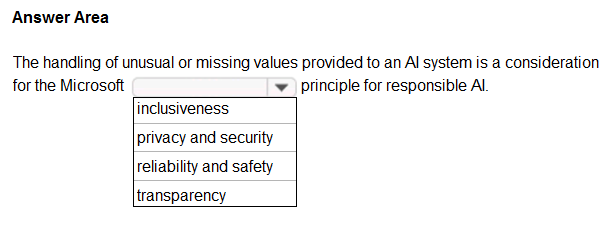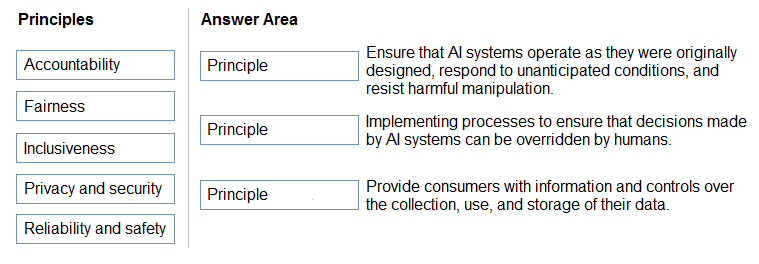AI-900: Microsoft Azure AI Fundamentals
A company employs a team of customer service agents to provide telephone and email support to customers.
The company develops a webchat bot to provide automated answers to common customer queries.
Which business benefit should the company expect as a result of creating the webchat bot solution?
increased sales
a reduced workload for the customer service agents
improved product reliability
Answer is a reduced workload for the customer service agents
To complete the sentence, select the appropriate option in the answer area.

inclusiveness
privacy and security
reliability and safety
transparency
Answer is reliability and safety
AI systems need to be reliable and safe in order to be trusted. It is important for a system to perform as it was originally designed and for it to respond safely to new situations. Its inherent resilience should resist intended or unintended manipulation. Rigorous testing and validation should be established for operating conditions to ensure that the system responds safely to edge cases, and A/B testing and champion/challenger methods should be integrated into the evaluation process.
An AI system's performance can degrade over time, so a robust monitoring and model tracking process needs to be established to reactively and proactively measure the model's performance and retrain it, as necessary, to modernize it. Reference:
https://docs.microsoft.com/en-us/azure/cloud-adoption-framework/innovate/best-practices/trusted-ai
Match the types of AI workloads to the appropriate scenarios.
To answer, drag the appropriate workload type from the column on the left to its scenario on the right. Each workload type may be used once, more than once, or not at all.

Check the answer area
Answer is 1. Conversational AI
2. Computer vision
3. Natural language processing
Sentiment analysis and opinion mining are features offered by Azure Cognitive Service for Language, a collection of machine learning and AI algorithms in the cloud for developing intelligent applications that involve written language. These features help you find out what people think of your brand or topic by mining text for clues about positive or negative sentiment, and can associate them with specific aspects of the text.
The Computer Vision Image Analysis service can extract a wide variety of visual features from your images. For example, it can determine whether an image contains adult content, find specific brands or objects, or find human faces.
Reference:
https://learn.microsoft.com/en-us/azure/cognitive-services/language-service/sentiment-opinion-mining/overview
https://learn.microsoft.com/en-us/azure/cognitive-services/computer-vision/overview-image-analysis?tabs=4-0
You are designing an AI system that empowers everyone, including people who have hearing, visual, and other impairments.
This is an example of which Microsoft guiding principle for responsible AI?
fairness
inclusiveness
reliability and safety
accountability
Answer is inclusiveness
Inclusiveness mandates that AI should consider all human races and experiences, and inclusive design practices can help developers to understand and address potential barriers that could unintentionally exclude people. Where possible, speech-to-text, text-to-speech, and visual recognition technology should be used to empower people with hearing, visual, and other impairments.
Reference:
https://learn.microsoft.com/en-us/azure/cloud-adoption-framework/innovate/best-practices/trusted-ai#inclusiveness
Match the Microsoft guiding principles for responsible AI to the appropriate descriptions.

Check the answer area
Answer is 1. Reliability and safety
2. Accountability
3. Privacy and security
AI systems need to be reliable and safe in order to be trusted. It's important for a system to perform as it was originally designed and for it to respond safely to new situations. Its inherent resilience should resist intended or unintended manipulation. Rigorous testing and validation should be established for operating conditions to ensure that the system responds safely to edge cases, and A/B testing and champion/challenger methods should be integrated into the evaluation process.
A data holder is obligated to protect the data in an AI system, and privacy and security are an integral part of this system. Personal needs to be secured, and it should be accessed in a way that doesn't compromise an individual's privacy. Azure differential privacy protects and preserves privacy by randomizing data and adding noise to conceal personal information from data scientists.
Accountability is an essential pillar of responsible AI. The people who design and deploy the AI system need to be accountable for its actions and decisions, especially as we progress toward more autonomous systems. Organizations should consider establishing an internal review body that provides oversight, insights, and guidance about developing and deploying AI systems. While this guidance might vary depending on the company and region, it should reflect an organization's AI journey.
Reference:
https://learn.microsoft.com/en-us/azure/cloud-adoption-framework/innovate/best-practices/trusted-ai#reliability-and-safety
https://learn.microsoft.com/en-us/azure/cloud-adoption-framework/innovate/best-practices/trusted-ai#privacy-and-security
https://learn.microsoft.com/en-us/azure/cloud-adoption-framework/innovate/best-practices/trusted-ai#accountability
To complete the sentence, select the appropriate option in the answer area.

inclusiveness
accountability
reliability and safety
fairness
Answer is reliability and safety
AI systems need to be reliable and safe in order to be trusted. It's important for a system to perform as it was originally designed and for it to respond safely to new situations. Its inherent resilience should resist intended or unintended manipulation. Rigorous testing and validation should be established for operating conditions to ensure that the system responds safely to edge cases, and A/B testing and champion/challenger methods should be integrated into the evaluation process.
Reference:
https://learn.microsoft.com/en-us/azure/cloud-adoption-framework/innovate/best-practices/trusted-ai#reliability-and-safety
You are building an AI system.
Which task should you include to ensure that the service meets the Microsoft transparency principle for responsible AI?
Ensure that all visuals have an associated text that can be read by a screen reader.
Enable autoscaling to ensure that a service scales based on demand.
Provide documentation to help developers debug code.
Ensure that a training dataset is representative of the population.
Answer is Provide documentation to help developers debug code.
Achieving transparency helps the team to understand the data and algorithms used to train the model, what transformation logic was applied to the data, the final model generated, and its associated assets. This information offers insights about how the model was created, which allows it to be reproduced in a transparent way. Snapshots within Azure Machine Learning workspaces support transparency by recording or retraining all training-related assets and metrics involved in the experiment.
Reference:
https://learn.microsoft.com/en-us/azure/cloud-adoption-framework/innovate/best-practices/trusted-ai#transparency
Match the types of AI workloads to the appropriate scenarios.

Check the answer area
Answer is
Computer vision = identify (object) letters
NLP = sentiment
Anomaly Detection = fraud
Maching Learning (regression) = predict
OCR or Optical Character Recognition is also referred to as text recognition or text extraction. Machine-learning based OCR techniques allow you to extract printed or handwritten text from images, such as posters, street signs and product labels, as well as from documents like articles, reports, forms, and invoices. The text is typically extracted as words, text lines, and paragraphs or text blocks, enabling access to digital version of the scanned text. This eliminates or significantly reduces the need for manual data entry.
Regression is a form of machine learning used to understand the relationships between variables to predict a desired outcome. Regression predicts a numeric label or outcome based on variables, or features. For example, an automobile sales company might use the characteristics of a car (such as engine size, number of seats, mileage, and so on) to predict its likely selling price. In this case, the characteristics of the car are the features, and the selling price is the label.
Sentiment analysis and opinion mining are features offered by Azure Cognitive Service for Language, a collection of machine learning and AI algorithms in the cloud for developing intelligent applications that involve written language. These features help you find out what people think of your brand or topic by mining text for clues about positive or negative sentiment, and can associate them with specific aspects of the text.
Anomaly Detector is an AI service with a set of APIs, which enables you to monitor and detect anomalies in your time series data with little machine learning (ML) knowledge, either batch validation or real-time inference.
Reference:
https://learn.microsoft.com/en-us/azure/cognitive-services/computer-vision/overview-ocr
https://learn.microsoft.com/en-us/training/modules/create-regression-model-azure-machine-learning-designer/2-regression-scenarios
https://learn.microsoft.com/en-us/azure/cognitive-services/language-service/sentiment-opinion-mining/overview
https://learn.microsoft.com/en-us/azure/cognitive-services/anomaly-detector/overview
Select the answer that correctly completes the sentence.

Key phrase extraction
Language detection
Named Entity Recognition (NER)
Sentiment Analysis
Answer is Named Entity Recognition (NER)
The NER feature can identify and categorize entities in unstructured text. For example: people, places, organizations, and quantities.
Reference:
https://learn.microsoft.com/en-us/azure/ai-services/language-service/named-entity-recognition/overview
For a machine learning progress, how should you split data for training and evaluation?
Use features for training and labels for evaluation.
Randomly split the data into rows for training and rows for evaluation.
Use labels for training and features for evaluation.
Randomly split the data into columns for training and columns for evaluation.
Answer is Randomly split the data into rows for training and rows for evaluation.
The Split Data module is particularly useful when you need to separate data into training and testing sets. Use the Split Rows option if you want to divide the data into two parts. You can specify the percentage of data to put in each split, but by default, the data is divided 50-50. You can also randomize the selection of rows in each group, and use stratified sampling. Randomly 75-25 split on row may be a good idea.
Reference:
https://docs.microsoft.com/en-us/azure/machine-learning/studio-module-reference/split-data#how-to-configure-split-data